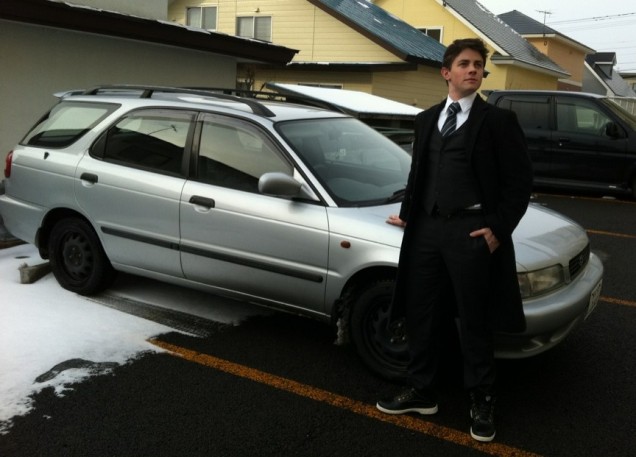By Ben Mirin, CIR
There is no test to obtain an international driver’s license for Japan…but there should be.
The Nanae Town government generously provides a personal car for its Coordinator of International Relations. The privilege of driving it, however, must be earned through several driving lessons on Japanese roads. For a CIR who arrives during the winter, these are especially pragmatic. Nanae’s snowplows are in short supply, and the few that patrol the town don’t disperse salt or other compounds (I’m told it’s for environmental reasons) to help melt the snow that accumulates almost every day.
I have driven in snow; after all, I’m from New England. Outside of this, my experience on American roads would prove more of a hindrance than an asset. Nevertheless, I approached my car with confidence and optimism. Japan is incredibly dynamic, and there are always opportunities for both foreigners and natives to try new things. With two weeks since my initiation as CIR, I was already well trained in embracing such chances with a positive attitude.

Seeing the car for the first time, I also remembered how Japan is a place of enduring traditions. The one I was to inherit that day was 13 years old, a Suzuki Cultus Crescent that had been passed down among all the CIRs since the job’s inception. From a leftover collection of Whitney’s mix CDs to a collection of scratches from Bobby’s bicycle, it was full of stories. Looking around, I was also glad to see seat belts in the back seat. Japan doesn’t require passengers in the back to wear them, but this is one Japanese practice I don’t expect I will adopt or permit.
Having withstood the trials of 5 different American drivers before me, this time-tested vehicle seemed worthy of my trust…but was I worthy of its keys?
My immediate confusion behind the wheel answered that question. After circling around the car in a search for the driver’s seat, I sat down and reached over my left shoulder for my seatbelt only to grasp empty air. I knew that everything about this car would be designed for driving on the left side of the road, but in true gaijin fashion I made almost every possible mistake until, finally, I started the engine and inched the car forward. From the passenger’s seat, my boss gave a courteous but somewhat apprehensive laugh as I turned onto the course, signaling with my windshield wipers.
Over the next hour, I charted every corner of the town office parking lot at an excruciating 10km per hour. Once in traffic, my temptation to drive in the wrong lane diminished (the oncoming cars helped), but a slew of other tendencies still required adjustment. My blind spot had changed sides, and traffic merges were suddenly a complex practice. Pedestrians who were accustomed to bows (even from drivers) met my hand signals with confused stares as I politely tried to let them cross the street.
As I continue my training, I am grateful for even the thought of an alternative to walking through Hokkaido’s winter weather. For the time being, however, I see many more parking lots in my future.
**********
Please consider leaving a comment on this post in the comment section below, or subscribing to the RSS feed to have future articles delivered to your feed reader.


To submit suggestions for future content, please email concordnanae@gmail.com. Thank you for visiting ConcordNanae.org.



Hi Ben,
About a use of salt for road de-icing, it make fish wear out really fast. I am working at Nanae fresh-water station, Hokkaido University now and I sometimes see fish rolling upside down after a lot of snow and dispersing salt on the high-way. Maybe, the water contained elevated levels of salts discharge out of high-way into Naru-kawa river after salting and it may influence fish’s behavior. However, in my opinion, this is only one reason why people do not disperse salt so much in Japan compared to US. Another is, in this country, there is a many geographic variation in climate and it is difficult to tackle the variation by only salting.
I like your website because your viewpoint is so unique for me. I am looking forward to the next post.
Thanks for the fascinating perspective, Taiju! I didn’t know that the effects of salting roads could be so apparent (have you confirmed that the salt is killing the fish?). You also make a very interesting point about Japan’s geographic variations. I’d love to talk more about this sometime.